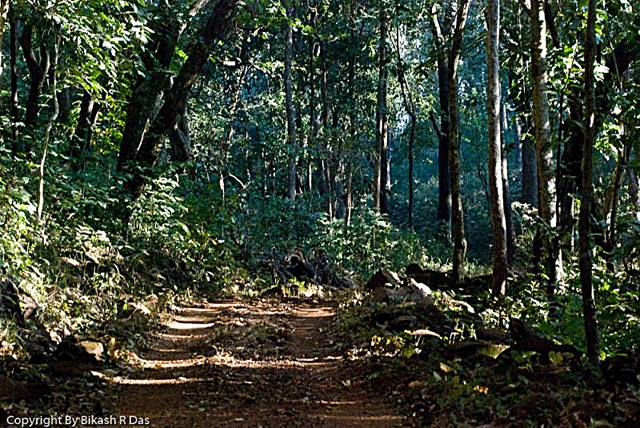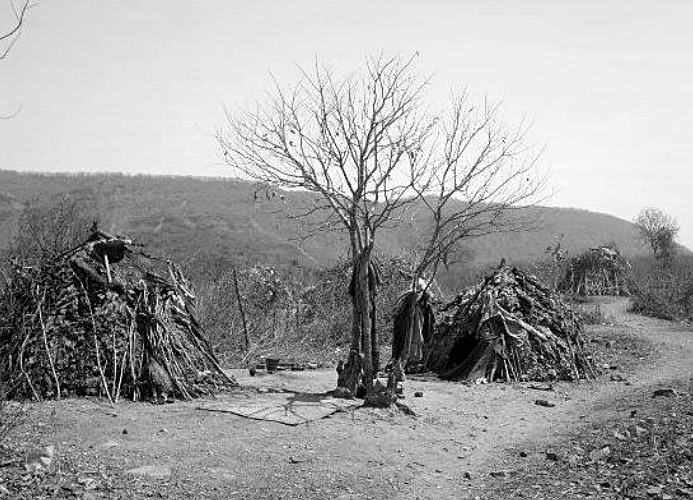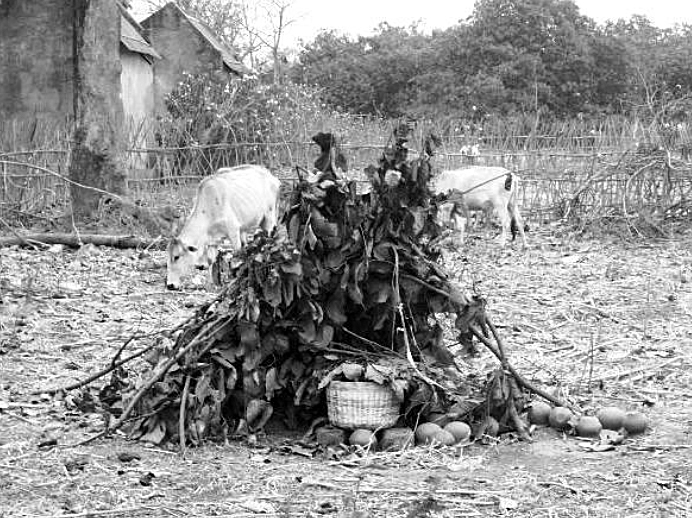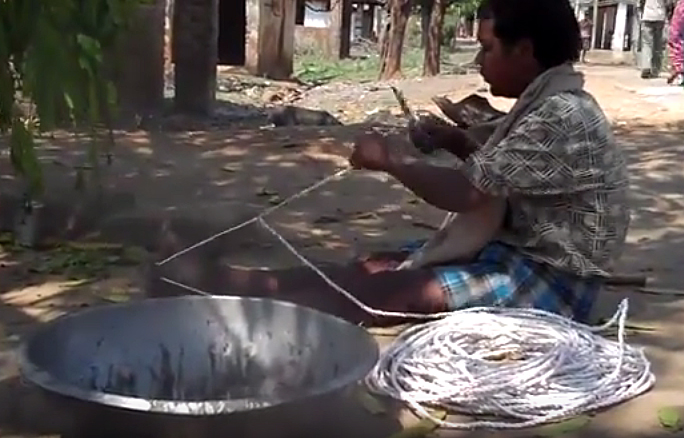The formerly nomadic Birhor are struggling to cope with their forced resettlement into permanent communities, which has had a serious impact on their cultural values. A recent journal article by Deborah Nadal examines these changes in Birhor settlement patterns over the past 50 years and their impact on the people.

Nadal did fieldwork in Dingura and Kendumundi, Birhor communities in the Mayurbhanj District of India’s Odisha state, plus Dauna, Chauparan, Sijhwa, Nagri, Dingura and Demotand in the Hazaribagh District of Jharkhand state. Dauna is the only one where the people still live in a tanda, a traditional, temporary settlement. Her research compared the tanda with the resettlement colonies.
She reports that a tanda was normally located at the edge of a forest tract, for easy access to gathering and hunting opportunities, but it was also situated not too far from villages with their markets. The Birhor liked to be reasonably close to markets where they could easily sell their handicrafts. The tandas were typically built under shade trees, near a water supply, and in the midst of bushes. The individual huts, the kumbhas, were scattered about, usually at least three meters apart.

Up to about 50 people lived in each tanda, and each kumbha, a cone-shaped or hemispherical hut about two meters across, held a family. The hut was built with available forest materials—long poles or branches pushed into the ground to form a framework, with smaller branches and leaves woven together and tied to the framework with vines to close the structure.
Other than the huts themselves, the traditional Birhor tanda had no other structures to suggest that it was a settled community—no gates, fences, or central meeting areas defining it as a place. That lack of permanence reflected the fact that the nomadic Birhor thought of themselves as free to move if they wished. The nuclear family was at the heart of their society rather than the group.
The traditional kumbha was often a solid structure when it was built properly. It sheltered the occupants when it rained and it was effectively insulated, retaining warmth in cooler weather yet providing cool relief from the blazing heat of hotter days. The foliage walls let in enough light to see by, yet helped keep the interior cool and dark. In essence, the kumbha was well suited to its environment. It had only one interior room that was normally left empty, but it was divided into a sleeping area, a storage area, and a cooking area.
But the government, in its wisdom, provided very different housing structures for the Birhor in the resettlement colonies. Called pukka houses, each one is normally a single level brick building with one room in the back and an open veranda in front. The structure has a single door between the two sections but no windows. The building, generally 3 meters (10 feet) by 3 meters, is built on a cement foundation with a concrete floor, and it has no wiring, plumbing, or furniture.

The colonies have gates, community halls, and fences around their perimeters that suggest permanence. They have central open spaces and roads with houses built close to one another, normally less than two meters apart. In contrast to the traditional tanda, it is impossible in the colonies to form clusters of huts for close relatives. In essence, it is difficult for a son who gets married to have a hut next to that of his parents, as he could in the tanda.
However, many Birhor have adapted their pukka houses to their needs. They have modified their verandas to make them the locus of their daily lives. Verandas that were built as open spaces on the fronts of the brick houses have been closed in on three sides with panels of sticks and leaves, or sometimes panels of brick walls. The verandas have thus become improvised kumbhas.
The Birhor still believe that they suffer misfortunes in the colonies because of the pukka houses. It seems that their ancestor spirits, called hapram bongas, have become disappointed—angered even—by the fact that their descendants have failed to build new kumbhas from time to time as they are supposed to do. The hapram are fundamentally benevolent spirits who are respected by the living Birhor and are worshiped regularly.
In response, the hapram look after and protect the living family members, interceding with the more vengeful gods. But one sign of the occasional anger of a hapram bonga will be leaks in the kumbhas. Such leaks in the traditional dwellings were easy to fix, of course, but they are much harder to repair in the pukka houses—and governmental authorities do not provide any assistance.

The hapram bonga requires a lot of care in return for his protection. When they used to live nomadically, the Birhor attended to the needs of their ancestor spirits by building small huts for them in their camps. Those huts, called bonga kumbhas, were normally much smaller and simpler than the huts made for humans. The people would put small stones or earth pots, which identified the spirits, in the huts and honor them with offerings of food and flowers. When they moved to another site, the Birhor had to follow carefully the proper ways of moving the bonga kumbhas as well.
All of this is important for the continuation of their peacefulness. Nadal argues that, just because a hapram bonga is the spirit of a deceased male, men do not necessarily rise to the status of hapram bonga when they die. The Birhor believe he must have behaved properly according to the social norms of his society. He must have had proper relations with his family members, he must have shared game correctly, and he must have behaved in a collaborative fashion. If he has done all those things properly, his funeral ceremony will start the process of him becoming a hapram bonga.
While the Birhor have been able to adapt, at least to some extent, to their altered circumstances in their new colonies, Nadal concludes, their need to constantly please the spirits of their departed ancestors has been severely altered if not destroyed. It is difficult for them to satisfy the desire of a hapram bonga to properly destroy his bonga kumbha and build a new one at a new location. Thus, the people have been forced to not only abandon their contacts with their beloved forests, but also they frequently lack the approval of their ancestors. In all, they have had to modify the cultural framework that defines them as “men of the forest.”

But the author sees some strength in the Birhor society. Despite their problems, they are still able to collect some minor forest products—roots, fruits, honey, and flowers. They can also collect the siali fibres that they use for making ropes, which they sell in the local markets or use themselves. Nadal believes they have a resilient culture. She is not convinced that ethnocide is necessarily at hand—it is a complex matter and the cultural resilience that the Birhor exhibit in some of their colonies affords some hope.
Nadal, Deborah. 2015. “Housing Ancestors: The Reorganization of Living Spaces among the Birhor of Jharkhand and Odisha.” Internationales Asien Forum. International Quarterly for Asian Studies 46(1/2), Spring: 39-58